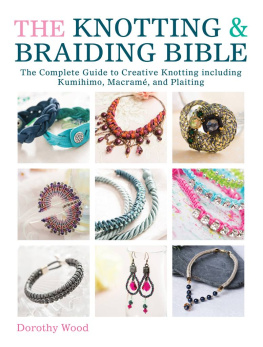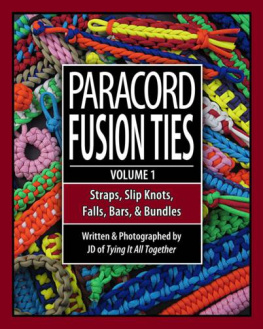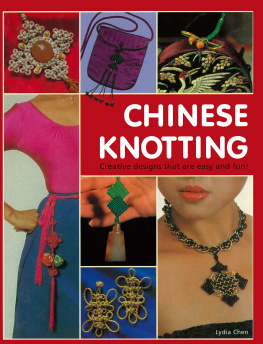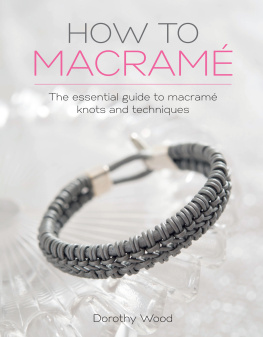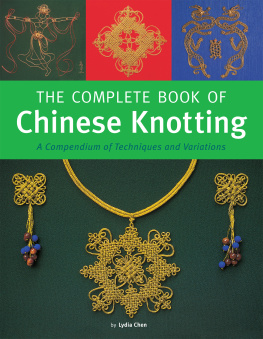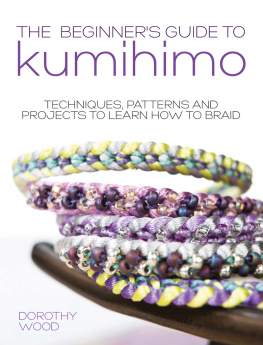Contents
All full-size templates can be found at www.stitchcraftcreate.co.uk/patterns
Introduction

Knotting and braiding are skills that have been around for centuries, and interest in the way they can be used in craft applications has grown in recent years. Although quite different, knots and braids are interlinked in many ways: they use cords or threads as a base, they are constructed with simple moves that can be combined to create quite complex structures, and they may benefit from being embellished with beads.
Ive been fascinated by knotting and braiding for many years: I remember watching my brother make his own toggle for his scout neckerchief and loved learning to tie knots myself in the Girl Guides, and at art college I used knotting techniques such as macram as a medium for some exciting wall hangings. In my first bible title, The Beaders Bible, I began to explore macram as a jewellery-making technique, so I am delighted to be able to build on these skills, researching and learning new techniques that I could share with you in this new book. Ive chosen an eclectic mix of knots and braids that are particularly suited to making jewellery, accessories and home-style applications and I hope that you will become just as enthusiastic as I am about trying out different techniques such as plaiting, Kumihimo and macram.
It is easier than ever to source materials for knotting and braiding gorgeous cords and threads in wonderful colours, interesting findings and fastenings, and easy-to-use equipment such as the disks and plates for Kumihimo. Whether you start at the beginning or dip in and out, youll find each technique clearly explained with step-by-step instructions illustrated with hundreds of photographs and diagrams. There are a dozen fabulous projects using the knots and braids in innovative ways, described in step-by-step detail with you will need requirements (see ), and as an added bonus, there are lots of additional mini ideas included throughout so that you can learn a technique and make something straight away!
Essential Equipment
If you are already a keen beader or craft person, much of the equipment and many of the materials listed are things that you will generally have in your workbox. You dont need to get everything at once as you can always improvise, but for best results it is better to use a similar material or the equipment and tools listed.
Cords and Threads
Knotting and braiding techniques can be worked in a huge variety of different threads and cords. The choices available are reviewed in this section, and for information about the most popular cords and threads used for Kumihimo see .
CHOOSING CORDS
Once you have learnt a technique, do experiment with different materials as you will be surprised at the results. Knots can lose definition when worked with a soft cord such as satin rattail or embroidery cottons, and the shape can be much more distinct when a stiffer cord such as Superlon, wax cotton, or round leather thong is used. Before you start, consider how you want the finished item to look and choose your cord or thread accordingly. Remember that each of these cords are available in a range of thicknesses and can be worked singly or in multiple bundles.

Cord guide
This sample board of cords shows at a glance some of the cords that are suitable for knotting and braiding and gives you a quick guide to the range of thicknesses available in the different cords.

Satin cord (rattail)
This silky cord has a high sheen and is available in a range of thicknesses: bugtail is 1mm thick, mousetail 1.5mm thick, and rattail is 2mm thick, however, in practice all tend to be called rattail now. The cord is quite soft so it doesnt support the shape of knots very well and it isnt very hard-wearing.
Chinese knotting cord
This nylon braided cord holds its round shape when it is worked. Currently available in 0.43mm, the thicker cords are particularly suitable for knotting techniques. Finer cords are popular for macram and Shamballa-style bead bracelets. Look online for the widest colour ranges, but you will find that the choice of colour for the thicker cords is not as extensive.
Wax cotton cord
Wax cotton cord is suitable for a range of techniques. Look out for thicker 3mm cord, which works particularly well for individual knots and knotted braids as it holds its shape well. Thinner wax cotton is ideal for macram and easy to string with beads. They are available in natural shades and a range of colours, many of which follow current fashion trends.
Tip
If wax cotton cord softens from overuse or you want to reuse a length, pull through under a medium hot iron to smooth kinks and restore the finish.
Superlon
Superlon (often abbreviated to S-lon) is an industrial strength twisted nylon cord originally used for upholstery. It is available in 0.5mm and 0.9mm widths and both are suitable for micro macram and other knotting techniques where you want a fine braid or finish. These cords are perfect for adding beads into your knotting or braiding and can be mixed with thicker cords for a change of texture. Both sizes are available in a range of neutrals and pretty contemporary colours.
Paracord
This chunky cord is commonly available in two thicknesses: paracord 550 (4mm) has seven strands down the centre and paracord 450 (2mm) has four centre strands. Paracord is perfect for making bracelets and other accessories from single knots and single width knotted braid, and as it is quite bulky, it is popular for mens jewellery. The cord is available in a wide range of solid bright and dark colours as well as in many multicoloured patterns.
Leather thong
Round leather thong makes a good distinct knot as it is a firm cord. It is available in a range of thicknesses from around 0.5mm up to 6mm. The thinner cords are good for tying knots and the thicker cords more suitable for use as a core to tie the knots around. Leather thong is available in natural shades and a wide range of colours. Pearlescent finishes, usually in pale pastels, are particularly attractive as are the different thicknesses of snakeskin effect cords.
Faux suede
This flat microfibre cord looks like real leather suede, but is much more pliable than the real thing and gives a completely different look to knots or knotted braids. It is generally 3mm wide and available in a range of colours.
Embroidery threads
Stranded cotton and cotton perl are just two readily available threads that can be used for knotting, plaiting and braiding. Embroidery threads are soft and wont hold the shape of a knot firmly but they look good when combined with stiffer cords. The colour range is much greater than for other cords, so exciting colour schemes are possible. While embroidery threads are usually matte, you can use metallic embroidery threads to add a touch of sparkle.

